 W
WSporting equipment, also called sporting goods, are the tools, materials, apparel, and gear used to compete in a sport and varies depending on the sport. The equipment ranges from balls, nets, and protective gear like helmets. Sporting equipment can be used as protective gear or a tool used to help the athletes play the sport. Over time, sporting equipment has evolved because sports have started to require more protective gear to prevent injuries. Sporting equipment may be found in any department store.
 W
WAn aerotrim is a 3-axis gimbal large enough to contain a human being, used for cardiovascular workout and equilibrioception (balance) training in pilots and astronauts. Aerotrims were used in gyms during the 1980s, but are currently out of production outside of professional applications. A handful of machines are still in circulation, largely used for entertainment at fairs and events and as science fiction showpieces in movies and television. Several companies around the world have picked up the idea and produced their own version with slight changes. One of the originals, made in Korea, can be found in Slovenia at Aerotrim Ekopool Celje.
 W
WAquatic timing systems are designed to automate the process of timing, judging, and scoring in competitive swimming and other aquatic sports, including diving, water polo, and synchronised swimming. These systems are also used in the training of athletes, and many add-on products have been developed to assist with the training process.
 W
WAssistive technology in sport is an area of technology design that is growing. Assistive technology is the array of new devices created to enable sports enthusiasts who have disabilities to play. Assistive technology may be used in disabled sports, where an existing sport is modified to enable players with a disability to participate; or, assistive technology may be used to invent completely new sports with athletes with disabilities exclusively in mind.
 W
WAn automatic scorer is the computerized scoring system to keep track of scoring in ten-bowling. It was introduced into bowling alleys in the 1970s and combined with mechanical pinsetters for detecting the pins bowled down. Automatic scorers took away the task of having to keep score by hand by using a specialized computer designed for the task of automatically keeping the tally.
 W
WA balance board is a device used as a circus skill, for recreation, balance training, athletic training, brain development, therapy, musical training and other kinds of personal development.
 W
WThe Bentley Fortissimo tennis racquet of 1972 was the first oversize tennis racquet to be produced and demonstrated publicly. Prior to its introduction, all tennis racquets were much smaller in terms of the stringbed size, measured in square inches. Today, that size, known as standard, is not used by any professional player for professional match play.
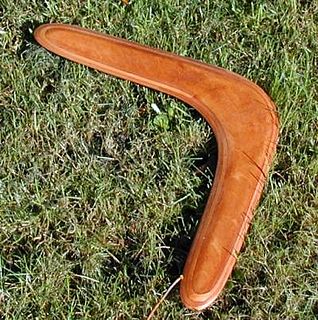 W
WA boomerang is a thrown tool, typically constructed as a flat airfoil, that is designed to spin about an axis perpendicular to the direction of its flight. A returning boomerang is designed to return to the thrower. It is well known as a weapon used by some Aboriginal Australian peoples for hunting.
 W
WEye black is a grease or strip applied under the eyes to reduce glare, although studies have not conclusively proven its effectiveness. It is a form of functional makeup.
 W
WIn field hockey, each player carries a stick and cannot take part in the game without it. The stick for an adult is usually in the range 89–95 cm (35–38 in) long. A maximum length of 105 cm (41.3") was stipulated from 2015. The maximum permitted weight is 737 grams. The majority of players use a stick in the range 19 oz to 22 oz. Traditionally hockey sticks were made of hickory, ash or mulberry wood with the head of the sticks being hand carved and therefore required skilled craftsmen to produce. Sticks made of wood continue to be made but the higher grade sticks are now manufactured from composite materials which were first permitted after 1992. These sticks usually contain a combination of fibreglass, aramid fiber and carbon fibre in varying proportions according to the characteristics required.
 W
WFlexible Flyer is a toy and recreational equipment brand, best known for the sled of the same name, a steerable wooden sled with steel runners.
 W
WA frisbee is a gliding toy or sporting item that is generally made of injection molded plastic and roughly 8 to 10 inches in diameter with a pronounced lip. It is used recreationally and competitively for throwing and catching, as in flying disc games. The shape of the disc is an airfoil in cross-section which allows it to fly by generating lift as it moves through the air. Spinning the disc imparts a stabilizing gyroscopic force, allowing it to be both aimed with accuracy and thrown for distance.
 W
WGlasses, also known as eyeglasses or spectacles, are vision eyewear, consisting of glass or hard plastic lenses mounted in a frame that holds them in front of a person's eyes, typically utilizing a bridge over the nose and hinged arms which rest over the ears.
 W
WA glider or sailplane is a type of glider aircraft used in the leisure activity and sport of gliding. This unpowered aircraft can use naturally occurring currents of rising air in the atmosphere to gain altitude. Sailplanes are aerodynamically streamlined and so can fly a significant distance forward for a small decrease in altitude.
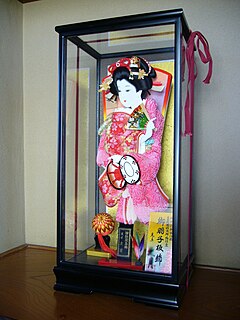 W
WHagoita are the wooden paddles used to hit shuttlecocks, traditionally made of soapberry seeds and bird feathers, that are used to play the traditional Japanese pastime called hanetsuki during the New Year. The paddles are decorated with various images, sometimes executed in relief, of women in kimono, kabuki actors, and so on. Japanese people think playing hanetsuki is a way to drive away evil spirits because the movement of the hagoita is similar to the harau action. Thus playing hanetsuki with hagoita is often used as a charm against evil.
 W
WHalteres were a type of dumbbells used in Ancient Greece. In Ancient Greek sports, halteres were used as lifting weights, and also as weights in their version of the long jump, Halteres were held in both hands to allow an athlete to jump a greater distance; they may have been dropped after the first or second jump. According to archaeological evidence, the athlete would swing the weights backwards and forwards just before take-off, thrust them forwards during take-off, and swing them backwards just before releasing them and landing. Halteres were made of stone or metal, and weighed between 2 and 9 kg.
A hand sack is any sack or similar object, typically made of cloth and filled with sand or a similar material, that is tossed on the back of the hand in a variety of games.
 W
WHarrod Sport is a British manufacturer of sporting equipment and netting based in Lowestoft, Suffolk. It is a family-run business founded in 1954 by the current chairman Ron Harrod, who converted fishing nets in to gardening and agricultural netting The association with sports began when Harrod Sport was approached to produce a pair of football nets and the accompanying football posts The business has expanded to employ over 136 individuals.
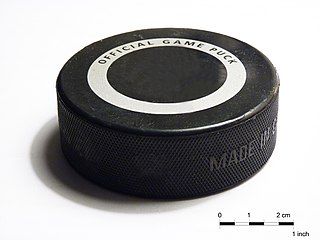 W
WA hockey puck is a disk made of vulcanized rubber that serves the same functions in various games as a ball does in ball games. The best-known use of pucks is in ice hockey, a major international sport. A hockey puck has also been referred to as a "Flat Ball."
 W
WJobe is a water sports brand and manufacturer of products used for wakeboarding, boating and standup paddleboarding. The Jobe headquarters and warehouse are located in Heerewaarden, Netherlands.
 W
WKegel, or kegeln, is a German bowling game, in which a player rolls a wooden or plastic ball along a smooth, hard indoor lane. The object of the game is to knock down the nine kegels at the other end of the lane. Kegel is a German derivative of European nine-pin bowling and is therefore closely related to its American counterpart, and bear similar elements to the traditional ten-pin bowling. It was also introduced to South Australia by German settlers in the 19th century and remains popular in areas in which many German people settled, such as the Barossa Valley.
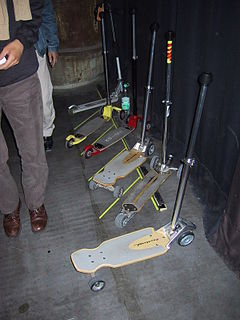 W
WA kick scooter is a human-powered street vehicle with a handlebar, deck, and wheels propelled by a rider pushing off the ground. Today, the most common scooters are made of aluminum, titanium, and steel. Some kick scooters made for younger children have 3 to 4 wheels and are made of plastic or don't fold. High-performance Kickbikes made for adults resemble the old "penny-farthing".
 W
WA kickbike is a type of kick scooter and is a human-powered street vehicle with a handlebar, deck, and wheels propelled by a rider pushing off the ground. The kickbike has a large standard size bicycle front wheel and a much smaller rear wheel, which allows for a much faster ride.
 W
WA line marker is a device or machine with which lines or markings are drawn on a sports field or pitch. They were originally developed to mark out lawn tennis courts on grass, but later also became used in many other sports with outdoor pitches. The marked lines are often white, but may be any color. A variety of devices have been used, some of them now being robotically controlled.
 W
WA nasal strip, external nasal dilator strip or nasal dilator strip is a type of adhesive bandage with embedded plastic ribs or splints that is applied across the bridge of the nose and sides of the nostrils, to assist in keeping the airway open. They are believed to make breathing easier and for that reason are used during athletic exertion and as an aid to reduce congestion or to prevent snoring. Various studies have indicated that they do not have a performance-enhancing effect. They are also used by race horse trainers on horses for similar reasons; they are thought to reduce airway resistance and lower the risk of exercise-induced pulmonary hemorrhage (EIPH), plus reduce fatigue and aid post-race recovery.
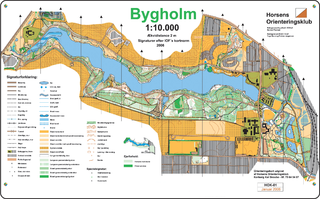 W
WAn orienteering map is a map specially prepared for use in orienteering competitions. It is a topographic map with extra details to help the competitor navigate through the competition area.
 W
WA parachute is a device used to slow the motion of an object through an atmosphere by creating drag. Parachutes are usually made out of light, strong fabric, originally silk, now most commonly nylon. They are typically dome-shaped, but vary, with rectangles, inverted domes, and others found. A variety of loads are attached to parachutes, including people, food, equipment, space capsules, and bombs.
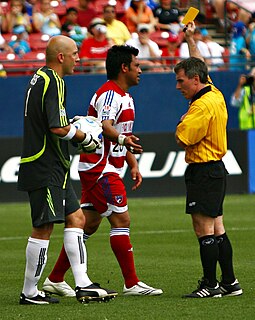 W
WPenalty cards are used in many sports as a means of warning, reprimanding or penalising a player, coach or team official. Penalty cards are most commonly used by referees or umpires to indicate that a player has committed an offence. The official will hold the card above his or her head while looking or pointing towards the player that has committed the offence. This action makes the decision clear to all players, as well as spectators and other officials in a manner that is language-neutral. The colour or shape of the card used by the official indicates the type or seriousness of the offence and the level of punishment that is to be applied. Yellow and red cards are the most common, typically indicating, respectively, cautions and dismissals.
 W
WThe penalty flag is a yellow cloth used in several field sports including American football and lacrosse by game officials to identify and sometimes mark the location of penalties or infractions that occur during regular play. It is usually wrapped around a weight, such as sand or beans so it can be thrown accurately over greater distances and cannot easily be blown away. Many officials previously weighted flags with ball bearings, but the practice was largely discontinued after a flag thrown by NFL referee Jeff Triplette struck Cleveland Browns offensive tackle Orlando Brown Sr. in the eye during a 1999 game, causing a serious injury to Brown. Brown was forced to sit out three seasons because of the eye injury and settled with the NFL for a reported amount of $25 million.
 W
WIn bowling, a pinsetter or pinspotter is an automated mechanical device that sets bowling pins back in their original positions, returns bowling balls to the front of the alley, and clears fallen pins on the pin deck. Prior to the machine's invention, pinsetters were originally young men stationed at bowling alleys to manually reset pins and return the ball. The first mechanical pinsetter was invented by Gottfried (Fred) Schmidt, who sold the patent in 1941 to AMF. Pinsetting machines have largely done away with pinsetting as a manual profession, although a small number of bowling alleys still use human pinsetters. While humans usually no longer set the pins, a pinchaser, or in slang "pin monkey", is often stationed near the equipment to ensure it is clean and working properly, and to clear minor jams.
 W
WA racegun or race gun is a firearm that has been modified for accuracy, speed, and reliability. Often a semi-automatic pistol, raceguns are used primarily in practical shooting competitions and are modified to function best within a certain set of rules, such as weight, size, and capacity requirements.
 W
WA racket or racquet is a sports implement consisting of a handled frame with an open hoop across which a network of strings or catgut is stretched tightly. It is used for striking a ball or shuttlecock in games such as squash, tennis, racquetball, rackets, badminton and padel. Collectively, these games are known as racket sports. Racket design and manufacturing has changed considerably over the centuries.
 W
WA scoreboard is a large board for publicly displaying the score in a game. Most levels of sport from high school and above use at least one scoreboard for keeping score, measuring time, and displaying statistics. Scoreboards in the past used a mechanical clock and numeral cards to display the score. When a point was made, a person would put the appropriate digits on a hook. Most modern scoreboards use electromechanical or electronic means of displaying the score. In these, digits are often composed of large dot-matrix or seven-segment displays made of incandescent bulbs, light-emitting diodes, or electromechanical flip segments. An official or neutral person will operate the scoreboard, using a control panel.
 W
WShooting glasses are specialized corrective glasses for use in shooting and are used almost exclusively in sport shooting competitions. Like other glasses, they are worn in front of the eyes to compensate for the shooter's ametropia with optical lenses.
 W
WA sled, sledge, or sleigh is a land vehicle that slides across a surface, usually of ice or snow. It is built with either a smooth underside or a separate body supported by two or more smooth, relatively narrow, longitudinal runners similar in principle to skis. This reduces the amount of friction, which helps to carry heavy loads.
 W
WSnauwaert is an Italian sports equipment manufacturer, focused on tennis and paddle tennis, producing mainly rackets. It was founded in 1928 by the brothers-in-law Valler Snauwaert and Eugeen Depla.
 W
WSnowboards are boards where both feet are placed, and most times secured, to the same board, which are wider than skis, with the ability to glide on snow. Snowboards widths are between 6 and 12 inches or 15 to 30 centimeters. Snowboards are differentiated from monoskis by the stance of the user. In monoskiing, the user stands with feet inline with direction of travel, whereas in snowboarding, users stand with feet transverse to the longitude of the board. Users of such equipment may be referred to as snowboarders. Commercial snowboards generally require extra equipment such as bindings and special boots which help secure both feet of a snowboarder, who generally rides in an upright position. These types of boards are commonly used by people at ski hills or resorts for leisure, entertainment, and competitive purposes in the activity called snowboarding.
 W
WSnowskates are a type of snow sport equipment intended to allow the user to emulate the actions of ice skating or inline skating on snow. They were first produced commercially in Germany in the 1930s.
 W
WA splitboard is a snowboard that can be separated into two ski-like parts used with climbing skins to ascend slopes the same way alpine touring or telemark skis are. Similar to cross country skiing, splitboarding allows free heel movement and with skins attached to the bottom of the skis, provides uphill traction. The two halves can then be connected to form a regular snowboard for descent. Splitboarding culture often focuses on the idea of using your own power to access the backcountry usually on unmaintained trails.
 W
WAerobics engineering is a fast growing field of engineering which encompasses the design and production of sports equipment and facilities, performance measurement and athletic feedback systems, and the study of kinematics, dynamics and biomechanics as they pertain to sport. The field overlaps other fields of science and engineering, including physics, mechanical engineering, electrical engineering, and materials science, and many practitioners hold degrees in those fields rather than in sports engineering specifically. While sports engineering is not a well known field among pre-college students, professional societies are working to change that. Study programs in sports engineering and technology at either the undergraduate or graduate level are now offered at a number of universities.
 W
WA basic table tennis paddle is used by table tennis players. The table tennis paddle is usually made from laminated wood covered with rubber on one or two sides depending on the player's grip. Unlike a conventional "racket", it does not include strings strung across an open frame. The USA generally uses the term "paddle" while Europeans and Asians use the term "bat" and the official ITTF term is "racket".
 W
WA thumb compass is a type of compass commonly used in orienteering, a sport in which map reading and terrain association are paramount. In cases of homogeneous terrain with few distinct features, a bearing between 2 known points on the map may be used. Consequently, most thumb compasses have minimal or no degree markings at all, and are normally used only to take bearings directly from a map, and to orient a map to magnetic north. Thumb compasses are also often transparent so that an orienteer can hold a map in the hand with the compass and see the map through the compass.
 W
WTiLite designs and manufactures titanium and aluminum wheelchairs. TiLite specializes in wheelchair customization in which each wheelchair is made to users' exact specifications.
 W
WA toboggan is a simple sled traditionally used by children. It is also a traditional form of transport used by the Innu and Cree of northern Canada.
 W
WTransponder timing is a technique for measuring performance in sport events. A transponder working on a radio-frequency identification (RFID) basis is attached to the athlete and emits a unique code that is detected by radio receivers located at the strategic points in an event.
 W
WThe Xiaomi Mi Band is a wearable activity tracker produced by Xiaomi, unveiled during a Xiaomi launch event on 22 July 2014. This article is mainly about the original Mi Band; later versions have separate articles.
 W
WThe Xiaomi Mi Band 2 is a low cost, wearable activity tracker produced by Xiaomi. It was released on 7 June, 2016. Unlike its predecessor, the Xiaomi Mi Band 2 comes with an OLED screen and a capacitive button. In September of 2017, Xiaomi released an ultra low-cost version of the Mi Band 2, titled "Mi Band - HRX Edition"
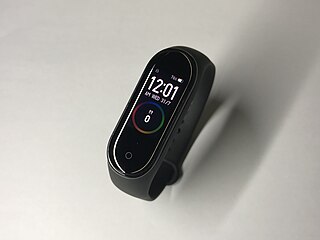 W
WThe Xiaomi Mi Band 4 is a wearable activity tracker produced by Xiaomi Inc released in China on 16 June 2019, in Europe on 26 June 2019 and in India on 19 September 2019. It is 39.9% larger than its predecessor, has a super capacitive AMOLED display and features 24/7 heart rate monitoring.